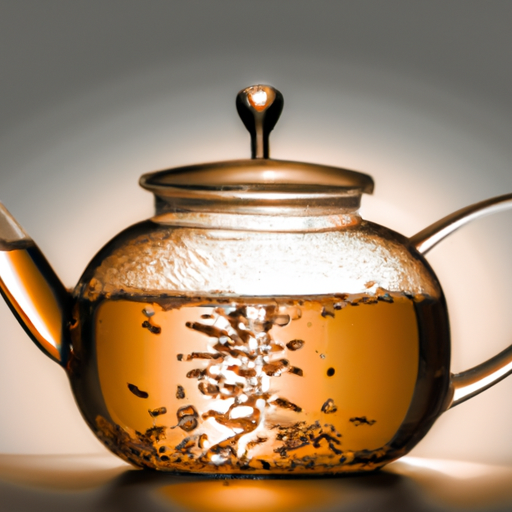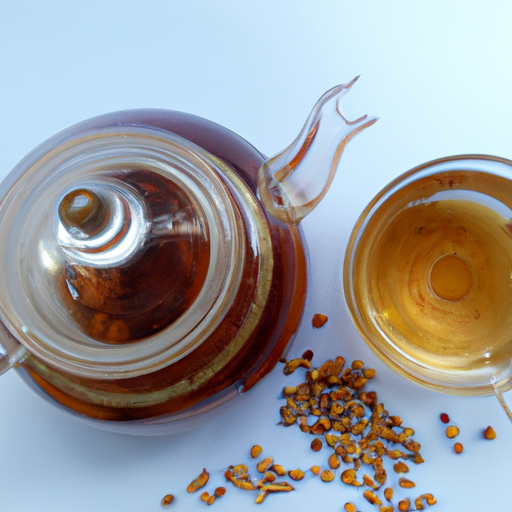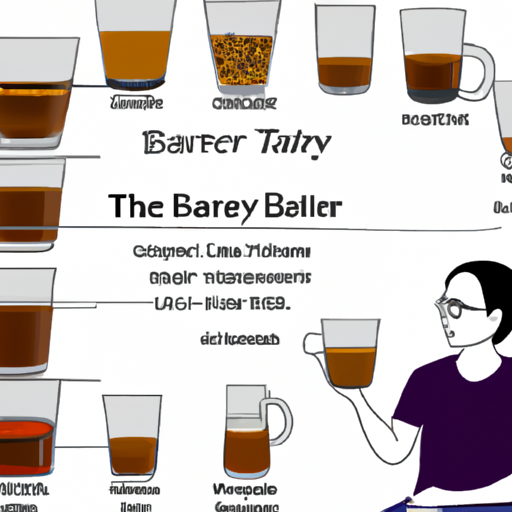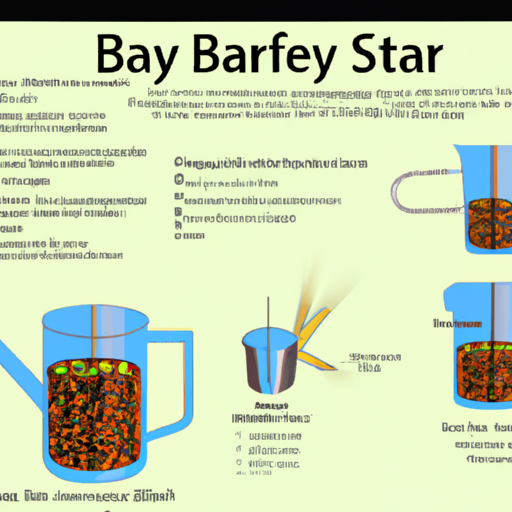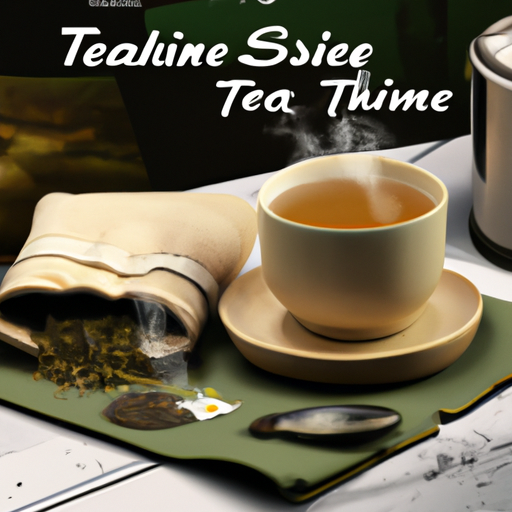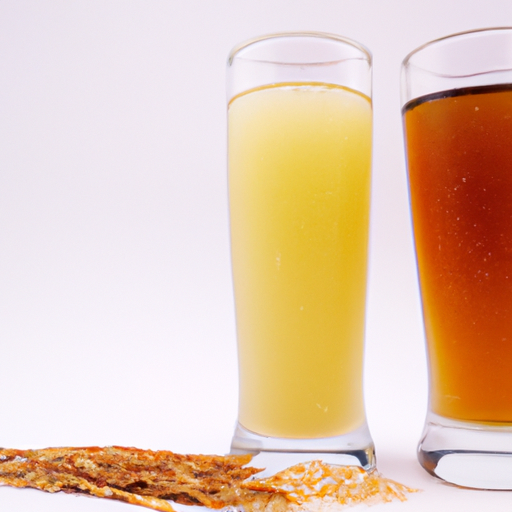As luck would have it, during my travels in Asia, I discovered the deep and flavorful taste of barley tea. Ever since, I’ve been keen to master the art of brewing it myself so I can savor it in the comfort of my own home.
After much experimentation and research, I have discovered the best methods for steeping barley tea and I am excited to share them with you.
Barley tea, also known as mugicha, is a popular beverage in many Asian countries and is known for its nutty and slightly sweet flavor. Unlike other teas, barley tea is not made from tea leaves but from roasted barley grains. This unique brewing process gives the tea a distinct taste and aroma that is both refreshing and comforting.
In this article, I will guide you through the steps of steeping barley tea and help you create a delicious and authentic mugicha experience in your own home.
Key Takeaways
- Choosing the right barley is important – hulled barley is the whole grain, while pearl barley has been polished. Roasting barley adds a toasty flavor.
- Properly preparing the barley grains includes washing, soaking, and toasting them. Water quality and pH can also affect the taste.
- The ratio of water to barley should be 1:10, and the grains should be boiled for 10-15 minutes. Straining the tea is important for a smooth and clear liquid.
- Barley tea can be enjoyed hot or chilled, with sweeteners or added flavors like lemon or ginger. Proper storage is crucial for maintaining freshness.
The Differences between Steeping Barley Tea and Other Teas
You might think steeping barley tea is just like steeping any other tea, but there are a few key differences to keep in mind.
For one, barley tea is not actually made from tea leaves, but from roasted barley grains. This means that the steeping methods and times may differ from those of tea.
Additionally, barley tea is known for its many health benefits, including aiding digestion, reducing inflammation, and promoting relaxation.
When it comes to steeping methods, there are a few things to keep in mind. First, the water temperature should be around 80-90 degrees Celsius, which is slightly cooler than what is typically used for tea. Additionally, the steeping time can vary depending on personal preference, but generally ranges from 5-10 minutes.
It’s also important to note that some people prefer to reuse the same barley grains for multiple steepings, which can result in a slightly weaker flavor.
In terms of health benefits, barley tea is a great choice for those looking for a caffeine-free alternative to traditional tea. It’s also a good source of antioxidants and can help improve circulation.
However, it’s important to choose the right barley in order to get the most out of these benefits. Look for high-quality, organic barley that has been properly roasted and stored.
With the right approach, steeping barley tea can be a delicious and healthful experience.
Choosing the Right Barley
When choosing barley for making tea, there are two main types to consider: hulled barley and pearl barley. Hulled barley is the whole grain with only the outermost hull removed, while pearl barley has been polished to remove the bran layer and some of the endosperm.
Additionally, you can choose between roasted and unroasted barley, which will affect the flavor and aroma of your tea. In my experience, I prefer using unroasted hulled barley for a milder and sweeter flavor profile.
Hulled Barley vs. Pearl Barley
Although hulled barley and pearl barley are both types of barley, they differ in the way they are processed. Hulled barley is a whole grain that has only had its outermost hull removed, while pearl barley has been polished to remove both the hull and bran layer. This process makes pearl barley less nutritious than hulled barley because it removes some of the fiber and nutrients. However, it also makes pearl barley faster to cook and easier to digest, which can be beneficial for some people.
When it comes to steeping barley tea, both hulled and pearl barley can be used, but each has its pros and cons. Hulled barley is more nutritious and has a nuttier flavor, but it takes longer to cook and can be harder to find. Pearl barley, on the other hand, is easier to find and cooks faster, but it has a milder flavor and is less nutritious. Ultimately, the choice between hulled and pearl barley for steeping barley tea will depend on personal preference and availability.
Moving on to the next subtopic, roasted barley vs. unroasted barley, let’s explore how each type can affect the flavor of barley tea.
Roasted Barley vs. Unroasted Barley
If you’re looking to add a deeper, nuttier flavor to your brew, roasted barley may be the way to go. Roasting barley adds a toasty, almost coffee-like flavor to the tea. However, it’s important to note that roasting does reduce some of the nutritional value of the barley, so it’s up to personal preference whether the flavor is worth sacrificing some of the health benefits.
To roast barley at home, start by preheating your oven to 350 degrees Fahrenheit. Spread a layer of unroasted barley on a baking sheet and place it in the oven for 15-20 minutes, or until the barley is a light golden brown. Be sure to stir the barley occasionally to ensure even roasting. Once the barley is roasted, let it cool before using it to steep your tea.
Preparing your barley grains is an important step in achieving the perfect cup of barley tea.
Preparing Your Barley Grains
Before steeping barley tea, it’s important to prepare the grains properly.
First, I usually wash the grains under running water to remove any dirt or debris.
Then, I soak the grains in water for several hours to soften them, which helps with the steeping process.
Lastly, I toast the grains in a dry pan over medium heat until they’re golden brown, which enhances their flavor.
These steps may seem small, but they can make a big difference in the taste and quality of your barley tea.
Washing and Soaking the Grains
First, rinse the barley grains thoroughly to remove any dirt or debris before soaking them in cold water for at least 30 minutes to release their flavor. To wash the grains, I use a fine-mesh strainer and run them under running water until the water runs clear. This ensures that any impurities are removed before soaking.
After washing, I transfer the grains to a bowl and cover them with cold water. I let them soak for at least 30 minutes, but sometimes I let them soak for up to an hour for a stronger flavor. Soaking the grains also helps to soften them, making it easier for the flavor to be extracted during steeping.
Once the soaking time is up, I drain the grains and move on to toasting them. Toasting the grains adds another layer of flavor to the tea and is a crucial step in the steeping process.
Toasting the Grains
Toasting the grains is an essential step in bringing out the full flavor of barley tea. There are a few toasting techniques that can be used to achieve the desired results.
One technique involves using a dry pan or skillet over medium heat. Once the pan is hot, add the grains and stir frequently until they are evenly toasted.
Another technique involves using an oven. Spread the grains evenly on a baking sheet and toast them in the oven at 350 degrees Fahrenheit for 10-15 minutes, stirring occasionally.
Toasting not only brings out a nutty aroma and golden color but also adds depth to the overall flavor profile of the brew. The toasting process caramelizes the natural sugars in the grains, creating a slightly sweet taste. The level of toasting can also affect the overall flavor profile, with lighter toasting producing a milder flavor and darker toasting producing a stronger, more robust flavor.
Now that the grains have been toasted to perfection, it’s time to move on to the next step of brewing barley tea – the importance of water quality.
The Importance of Water Quality
Although some may argue that water quality isn’t crucial in steeping barley tea, it can greatly affect the taste and overall quality of the brew. As someone who’s experimented with various water types, I can confidently say that the importance of water filtration can’t be overstated when making a delicious cup of barley tea.
Here are three reasons why:
-
Water hardness can alter the taste of the tea. Hard water contains high levels of minerals such as calcium and magnesium, which can create a bitter taste in the tea. This can be avoided by using filtered or soft water instead.
-
Chlorine in tap water can affect the flavor. Although chlorine is added to tap water to kill bacteria, it can also affect the taste of barley tea. Chlorine can give the tea a chemical taste, which is why it’s important to filter tap water or use bottled water if possible.
-
Testing water pH can ensure optimal flavor extraction. The pH level of the water can affect how well the barley tea flavor is extracted. Ideally, the pH level should be between 6.5 and 7.5 for best results. Testing the pH level of your water can help you achieve the ideal flavor.
When it comes to steeping barley tea, the water quality can make a significant difference. After ensuring that the water quality is optimal, the next step is boiling the barley grains to release their flavorful aroma.
Boiling the Barley Grains
When steeping barley tea, it’s important to understand the proper ratio of water to barley and the appropriate boiling time.
As I begin the process, I measure out the correct amount of barley and water, ensuring that the tea is not too weak or too strong.
Then, I bring the water to a rolling boil, allowing the barley grains to release their full flavor and aroma.
Ratio of Water to Barley
First things first, you’ll want to make sure you have the right ratio of water to barley for the perfect cup of tea. The ideal ratio is 1:10, meaning one cup of barley grains to ten cups of water. This ratio is important because it affects the overall strength and flavor of the tea.
To help you visualize the perfect ratio, here are three things to keep in mind:
- The barley grains should be able to move freely in the water.
- The water should be enough to cover the barley grains by at least an inch.
- The water should not be too much or too little that it affects the boiling duration and consequently, the flavor.
With the right ratio, you can now move on to the next step which is boiling the barley grains. The boiling duration is crucial to bring out the best flavor of the tea, so make sure to keep an eye on it.
Boiling Time
Now that we’ve established the correct ratio of water to barley, let’s move on to the boiling time. This step is crucial in bringing out the distinct nutty flavor and aroma of barley tea. Adjusting the temperature and using a timer are essential in achieving the perfect boil.
Once you’ve added the barley to the water, bring it to a boil over high heat. Once it reaches a rolling boil, reduce the heat to medium-low and let it simmer for 10-15 minutes. Using a timer is recommended to ensure that the tea is not overcooked, which can result in a bitter taste. Adjusting the temperature is also important, as boiling the tea too rapidly can cause the water to evaporate too quickly, resulting in a concentrated brew.
As we move on to the next step of straining the tea, it’s important to keep in mind that the steeping process is just as important as the boiling time.
Straining the Tea
As you pour the steeped barley tea through the strainer, watch as the golden liquid cascades down like a waterfall, leaving behind the grainy remnants in the filter. Using a strainer for barley tea is an essential step that ensures a smooth and clear liquid. The tea strainer can be made of different materials such as metal, cloth, or paper, but always ensure that it’s clean before use.
Once you’ve strained the barley tea, there are different ways to enjoy it. You can drink it hot, like a regular tea, or chilled, which is a perfect drink for a hot summer day. For a sweeter drink, you can add honey or sugar, or even experiment with other flavorings like lemon or mint. The options are endless, and it all depends on your personal taste and preference.
Now that you’ve strained the barley tea, it’s time to add sweeteners or flavorings to give it that extra kick. Whether you prefer it plain or with added flavors, make sure to use high-quality ingredients for the best taste. Adding sweeteners or flavorings can enhance the taste of the barley tea, bringing out the nutty and earthy flavors that make it unique. So go ahead, experiment, and enjoy your freshly brewed barley tea!
Adding Sweeteners or Flavorings
When it comes to adding sweeteners or flavorings to my barley tea, I have a few go-to options.
First, I love adding a touch of honey for a natural sweetness that complements the nutty flavor of the tea. If I want something a bit more traditional, I’ll add a spoonful of sugar. For a healthier alternative, I’ll use agave instead.
Additionally, I often add a slice of lemon or a bit of ginger to give the tea an extra kick of flavor. These simple additions can really elevate the taste of your barley tea and make it a refreshing and delicious beverage.
Honey, Sugar, or Agave
Opt for honey, sugar, or agave to sweeten your barley tea and elevate its flavor profile. While all three sweeteners can be used in barley tea, each one brings its unique flavor and benefits. Honey, for example, is a natural sweetener that adds a subtle floral note to your tea. It also has antibacterial properties, making it a great choice for soothing sore throats and coughs. Additionally, honey has antioxidants and can help boost your immune system.
Agave, on the other hand, is a vegan-friendly sweetener that has a lower glycemic index than honey or sugar. This makes it a great option for people with diabetes or those looking to reduce their sugar intake. Agave also has a mild, slightly nutty flavor that pairs well with roasted barley tea. You can also experiment with using agave in different tea blends to create unique flavor combinations. Sugar, although not as healthy as honey or agave, is a classic sweetener that can be used if you don’t have honey or agave on hand.
Adding lemon or ginger to your barley tea can further enhance its flavor and provide additional health benefits.
Lemon or Ginger
Now that we’ve discussed the sweeteners you can use in your barley tea, let’s move on to adding some extra flavor with lemon or ginger.
Adding a slice of lemon to your barley tea not only enhances the flavor but also provides some health benefits. Lemon is known to aid digestion and boost the immune system with its high vitamin C content. It also adds a refreshing citrusy taste to your drink.
If you’re feeling adventurous, try using ginger for a spicy twist in your barley tea. Ginger has anti-inflammatory properties and is known to alleviate nausea and motion sickness. Simply add a few slices of fresh ginger to your tea while steeping and enjoy the warmth and kick of this flavorful root.
Now that we’ve discussed how to add some extra flavor to your barley tea, let’s move on to serving and storing your delicious drink.
Serving and Storing Your Barley Tea
Alright folks, once you’ve brewed your delicious barley tea, it’s time to think about how to serve and store it for later. After all, you don’t want your hard work to go to waste.
Storing techniques are crucial in maintaining the freshness of your tea. First, you need to let the tea cool down to room temperature before transferring it to an airtight container. Glass bottles or jars with tight lids are perfect for storing barley tea. Make sure to keep it away from sunlight and heat to prevent spoilage. Your tea should last in the fridge for up to a week.
Now that you know how to store your barley tea, let’s talk about serving suggestions. Traditionally, barley tea is served either hot or cold, depending on your preference. You can add ice cubes to make a refreshing summer drink or heat it up for a cozy winter beverage. Some people like to sweeten their tea with honey or sugar, while others prefer it plain.
Experiment with different serving styles to find what suits your taste buds best. Serving and storing your barley tea is just as important as brewing it. Follow the proper storage techniques to maintain the freshness of your tea and try different serving suggestions to enhance its flavor.
Now that you have your barley tea ready to go, let’s move on to the next section about experimenting with different variations. Who knows, you may discover a new favorite way to enjoy your barley tea!
Experimenting with Different Variations
Now that I’ve mastered the art of steeping barley tea, I can’t wait to experiment with different variations.
I’m excited to try adding different herbs, fruits, or sweeteners to create unique flavors.
I’m also looking forward to enjoying my homemade barley tea with friends and family and sharing my recipe with them.
Enjoying Your Homemade Barley Tea
Don’t forget to add a touch of honey or lemon to your homemade barley tea for a delightful twist on this classic drink.
Aside from its refreshing taste, barley tea offers numerous health benefits. It’s known to aid digestion, improve blood circulation, and relieve stress.
The brewing technique used to make barley tea also helps to release antioxidants and vitamins that are beneficial to the body.
To enjoy your homemade barley tea, try serving it cold over ice or hot with a dash of milk for a creamy texture. You can also experiment with different variations by adding mint leaves or cinnamon sticks for an extra burst of flavor.
Sharing your recipe with friends and family is a great way to introduce them to the wonderful world of barley tea and its health benefits. So go ahead and brew up a batch, sit back, and savor the flavor of your homemade barley tea.
Sharing Your Recipe with Friends and Family
Sharing your homemade barley tea recipe with friends and family is like spreading the warmth and comfort of a cozy blanket on a chilly day. Not only will you be able to share the benefits of drinking barley tea, but you’ll also be able to host tea parties and create lasting memories with loved ones.
When sharing your recipe, be sure to highlight the health benefits of barley tea, such as its ability to aid in digestion and reduce inflammation. Additionally, emphasize the simplicity of the recipe and how easy it is to make at home. You can even package your barley tea in a cute jar or bottle and add a personalized label to give it that extra special touch.
Tea parties are a great way to bring people together and celebrate the simple pleasures in life. By sharing your homemade barley tea and recipe, you’ll not only be able to enjoy a warm and comforting drink, but you’ll also be able to create a sense of community and connection with those around you.
So why not gather your friends and family, brew a pot of barley tea, and enjoy the warmth and comfort that comes with sharing something homemade with those you love.
Frequently Asked Questions
What are the health benefits of drinking barley tea?
Drinking barley tea as a coffee substitute can offer a range of health benefits. It’s naturally caffeine-free and contains antioxidants that can help improve blood circulation and reduce the risk of heart disease. Barley tea has also been shown to aid in weight loss by suppressing appetite and boosting metabolism. By incorporating barley tea into your diet, you can enjoy a refreshing and healthy alternative to coffee. Plus, you’ll reap the nutritional benefits it provides.
Can I reuse the barley grains for multiple steepings?
Well, I hate to be the bearer of bad news, but you can’t reuse the same barley grains for multiple steepings. While it may seem thrifty, the flavor profile of the tea will change with each steeping and not for the better. Barley tea is best enjoyed when the grains are only steeped once, allowing for the full flavor and health benefits to shine through.
Using fresh barley grains with each steeping ensures that you’re getting the most out of your tea. So while it may be tempting to reuse your grains, it’s best to stick to a one-time use for the best tasting and healthiest barley tea.
How long can I store brewed barley tea before it goes bad?
When it comes to brewed barley tea storage, it’s important to keep in mind the shelf life of the tea. Once the tea has been brewed, it should be stored in a clean and airtight container in the refrigerator. If stored properly, brewed barley tea can last for up to two weeks.
However, it’s important to note that the flavor and quality of the tea will begin to deteriorate over time. To ensure the best taste, it’s recommended to consume the tea within the first week of brewing. Additionally, it’s important to avoid leaving the tea at room temperature for extended periods of time, as this can promote bacterial growth and spoilage.
By following these guidelines, you can enjoy fresh and delicious barley tea for as long as possible.
Can I use a tea infuser to steep my barley tea instead of straining it?
Yes, you can definitely use a tea infuser to steep your barley tea instead of straining it. While some may argue that using a strainer is the traditional and more effective method, there are also a variety of tea infuser alternatives that work just as well.
When it comes to steeping techniques, it’s important to keep in mind the temperature and steeping time for the best flavor. Barley tea is typically steeped in hot water for about 5-10 minutes, depending on your preference.
Using a tea infuser can also make cleanup easier and more convenient. Just make sure to choose an infuser with large enough holes to allow the barley to expand and fully infuse its flavor into the water.
Is it okay to add milk or cream to barley tea?
Adding milk or cream to barley tea is a matter of personal preference. While some people enjoy the rich and creamy taste that milk or cream can add to their tea, others prefer to enjoy the natural flavor of the barley without any additional flavorings.
If you choose to add milk or cream to your barley tea, it’s important to use the right amount to ensure that the flavor of the tea is not overwhelmed. A good rule of thumb is to use about one tablespoon of milk or cream per cup of tea. You can also experiment with different types of milk or cream, such as almond milk or coconut cream, to find the flavor that works best for you.
Overall, adding milk or cream to barley tea can be a delicious way to enhance the flavor of this healthy and refreshing beverage.
Conclusion
So that’s how you steep barley tea! As someone who enjoys a good cup of tea, I’ve always been curious about the process of steeping barley tea. It’s fascinating to learn about the differences between steeping barley tea and other teas, and how important it is to choose the right barley and prepare it properly.
One interesting statistic that I came across in my research is that barley tea is the most commonly consumed tea in Korea, accounting for over 40% of all tea consumed in the country. This speaks to the popularity and cultural significance of barley tea in Korea, and highlights the importance of tea in their daily lives.
It’s also interesting to note that barley tea has been consumed in Korea for centuries, dating back to the Joseon Dynasty. This shows how deeply ingrained tea culture is in Korea, and how it has been passed down from generation to generation.
Overall, steeping barley tea is a simple yet rewarding process that can be enjoyed by anyone. By following these steps, you can make a delicious cup of barley tea that’s not only refreshing but also has numerous health benefits. So why not give it a try and experience the joy of steeping your own barley tea?

